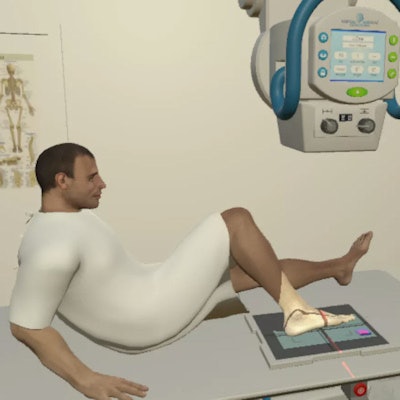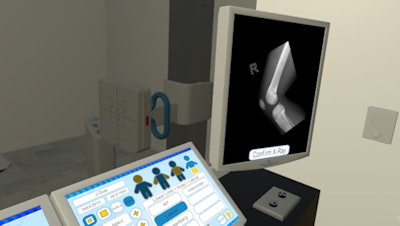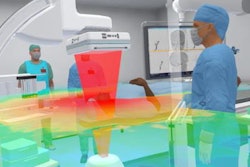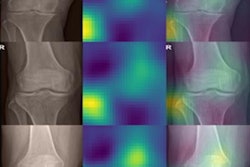
A New Zealand start-up called Virtual Medical Coaching aims to reinvent radiographer and radiologic technologist (RT) training by making it more virtual, more personalized, more flexible, and above all more relevant for students.
Virtual Medical Coaching wants to replace today's clunky monitor-based learning modules with the tangible experience of a virtual patient interaction and controls tailored precisely to the machine the student is learning to operate.
 James Hayes, CEO of Virtual Medical Coaching.
James Hayes, CEO of Virtual Medical Coaching.Virtual learning is better than conventional training, the company maintains, because students can adjust the patient on the table, push the buttons and twist the dials, and expose the patient in a way that is remarkably similar to working on a real x-ray machine and with a real patient, according to James Hayes, president and CEO of Virtual Medical.
"Some students say they have found it very difficult to complete their exams using the simulation equipment at the universities because what they were using to train on was so very different from the clinical equipment they were using in the hospitals," Hayes told AuntMinnie.com. "One of them said it's like learning to samba dance and then being tested in salsa."
The 'real' thing
The complex mental gymnastics needed to learn the right lessons on the wrong machine are a thing of the past with virtual learning, Hayes said. To use the Virtual Medical Coaching system, a student simply dons a pair of goggles, walks into the virtual x-ray room, and performs radiographic exams just as he or she would in the real world, either alone or following a trainer's audio instructions.
"Most students are learning on gear that was decommissioned from hospitals 20 years ago," added Greg Urqhurt, Virtual Medical's business development manager. "They're using gear that's not current and doesn't even have the same buttons or the same movements as the current equipment. And students don't get to irradiate, so they can't actually push the button."
With virtual training, students can create and manipulate images and receive measurable feedback in ways that aren't possible using conventional training techniques. Students can also perform all of the steps involved in acquiring images in a risk-free environment, Hayes said, and they can do so in a classroom, at home, or really anywhere in the world, just by logging in and putting on the goggles and a virtual hand.
Ultimately, students can approach learning in the way that best suits their individual skills and prior knowledge. Each student has to end up as a competent technologist or radiographer, "but how they get there can be very different," Hayes said.
Tired trainers, subjective measurements
Things are more complicated with conventional training on a live model, where students are evaluated one on one by a tutor on various aspects of their technique. This process is inherently subjective and difficult to repeat consistently between students, or even when used to compare the same student on a different date, Hayes said.
Virtual coaching offers the ability to collect a wide variety of data during each training session regarding precision, completion time, and frequency or magnitude of errors, and the data are objective, making the information consistent across students and testing periods. In addition, because these measures are objective, training can become more consistent across students.
"With objective data, I can tell the student that four of your five exercises were great, but on the last one you just didn't rotate enough," Hayes said.
Metric evaluation enables students to be told precisely, for example, that an underrotation amounted to 2°. In a conventional training setting, the tutor might be tempted to let a student slide who is making mistakes if his or her performance is generally competent.
"Metric data means that good students still have to perform in a good way," Urqhurt said.
 Above, a student's-eye view inside the virtual reality control room during the acquisition of a knee x-ray. Below, a virtual patient prepares to undergo an x-ray of the ankle. All images courtesy of James Hayes.
Above, a student's-eye view inside the virtual reality control room during the acquisition of a knee x-ray. Below, a virtual patient prepares to undergo an x-ray of the ankle. All images courtesy of James Hayes.Getting started
Virtual Medical Coaching is a brand new enterprise, according to Urqhurt, launched in Christchurch following an intensive two-year development period and a lot of programming. The infrastructure requirement for the modules has been extensive, especially for simulations of the human anatomy, which can respond with intricate precision whenever body parts are moved. The company has simulations of male and female patients in its database, including obese patients.
Virtual Medical Coaching is currently being used at the Ara Institute of Canterbury, which begins training its radiography students with the system this year. Meanwhile, Hayes and Urqhurt are busy promoting it to other schools around the globe, as well as to OEMs, which can have the modules customized to their latest x-ray equipment to facilitate adoption.
"We could put the latest Toshiba machine into this very easily, and Toshiba could then sell a machine into the university," Urqhurt said.
Universities are also potential clients, and, finally, there are many people who come into radiology after they've maybe been gone for a few years and need a good refresher course.
For schools, education costs fall markedly when institutions adopt the technology, Hayes said. This is because they suddenly need fewer trainers and fewer rooms, and they can have as many students learning at once as they wish, wherever they may be located around the globe.
"So it's changing the game for education, and there are also a lot of manufacturers who have to freight all of their equipment around to shows," Hayes said. Vendors attending smaller shows and customer demonstrations might do just as well with a good simulation program.
"When you're talking about a machine that costs up to $1.2 million, putting money into virtual reality just makes sense," he said.



















